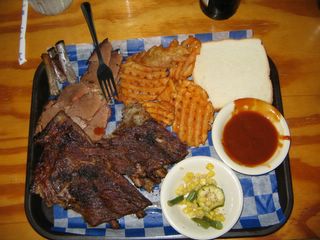
Here is a microeconomic action that all of us can act on today:
Last year researchers at the University of Chicago took the Prius down a peg when they turned their attention to another gas guzzling consumer purchase. They noted that feeding animals for meat, dairy, and egg production requires growing some ten times as much crops as we'd need if we just ate pasta primavera, faux chicken nuggets, and other plant foods. On top of that, we have to transport the animals to slaughterhouses, slaughter them, refrigerate their carcasses, and distribute their flesh all across the country. Producing a calorie of meat protein means burning more than ten times as much fossil fuels--and spewing more than ten times as much heat-trapping carbon dioxide--as does a calorie of plant protein. The researchers found that, when it's all added up, the average American does more to reduce global warming emissions by going vegetarian than by switching to a Prius.
According to the UN report, it gets even worse when we include the vast quantities of land needed to give us our steak and pork chops. Animal agriculture takes up an incredible 70% of all agricultural land, and 30% of the total land surface of the planet. As a result, farmed animals are probably the biggest cause of slashing and burning the world's forests. Today, 70% of former Amazon rainforest is used for pastureland, and feed crops cover much of the remainder. These forests serve as "sinks," absorbing carbon dioxide from the air, and burning these forests releases all the stored carbon dioxide, quantities that exceed by far the fossil fuel emission of animal agriculture.
As if that wasn't bad enough, the real kicker comes when looking at gases besides carbon dioxide--gases like methane and nitrous oxide, enormously effective greenhouse gases with 23 and 296 times the warming power of carbon dioxide, respectively. If carbon dioxide is responsible for about one-half of human-related greenhouse gas warming since the industrial revolution, methane and nitrous oxide are responsible for another one-third. These super-strong gases come primarily from farmed animals' digestive processes, and from their manure. In fact, while animal agriculture accounts for 9% of our carbon dioxide emissions, it emits 37% of our methane, and a whopping 65% of our nitrous oxide.
It's a little hard to take in when thinking of a small chick hatching from her fragile egg. How can an animal, so seemingly insignificant against the vastness of the earth, give off so much greenhouse gas as to change the global climate? The answer is in their sheer numbers. The United States alone slaughters more than 10 billion land animals every year, all to sustain a meat-ravenous culture that can barely conceive of a time not long ago when "a chicken in every pot" was considered a luxury. Land animals raised for food make up a staggering 20% of the entire land animal biomass of the earth. We are eating our planet to death.
What we're seeing is just the beginning, too. Meat consumption has increased five-fold in the past fifty years, and is expected to double again in the next fifty.
It sounds like a lot of bad news, but in fact it's quite the opposite. It means we have a powerful new weapon to use in addressing the most serious environmental crisis ever to face humanity. The Prius was an important step forward, but how often are people in the market for a new car? Now that we know a greener diet is even more effective than a greener car, we can make a difference at every single meal, simply by leaving the animals off of our plates. Who would have thought: what's good for our health is also good for the health of the planet!
I love my meat as much as the next person, but it is still a choice, not a necessity in our diets. In the near future, when the problems of overpopulation and resource depletion are palpable and requiring sacrifices from us all for the sake of the planet, going vegetarian might become the accepted and expected norm and not the exception. Or at least a modified diet with a lot less meat protein. What really would be the big deal with switching all the fast food joints over to soy products? It's not like the food could taste any worse or provide any less food value. What do you think? Soylent Green for/from everyone!
2 comments:
I like my meat. That being said, I have tried soy products before and I do like them . A veggie burger does not taste that different from a cattle burger once all the fixings are on it. But zuccini can't replace the taste of bacon..mmmmmmmmm bacon. I do agree that our consumption of everything is adding to our planet's woes, but I think if people followed a healthy diet and ate the required amount of protein a day, it would cut lots of this waste and production in half. I mean look at that picture you posted on here. Is it neccessary to have two different types of meat? Not really but we take it as the norm these days. I'm bad for that I know. There isn't anything of health value on that pic whatsoever besides that teeny bit of sald that is probably laced with a high fat dressing. Instead it should be one meat proper portion and the rest veggies and maybe a few potatoes fried in a little bit of olive oil. ANd the white bread, yuck! That's bird food. A nice multi-grain bun with Becel would be better.
I agree. Smaller, healthier portions all around. And that pic was the Texas steakhouse staple when I was down there last year. We'll probably head out there again next week too! Good to poison your arteries once a year, I always say!
Post a Comment